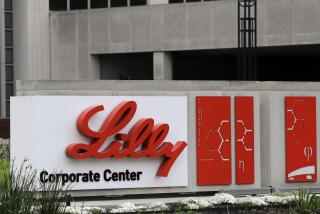Prescription for Pharmacist Shortage
- Share via
America is short of pharmacists to properly dispense the more than $70 billion in prescription drugs that we take each year, and the serious shortage is expected to get worse.
With all of the world’s other problems, the need for more pharmacists may seem to be minor. But they are a crucial part of our health-care system, and their mistakes can be devastating.
As the number of the elderly rises, so does the demand for prescription drugs and therefore for people to fill them. And we also need increasingly skilled pharmacists, as they must deal these days with the complexities of nuclear medicine and new drug therapy programs.
Several studies have shown that hundreds of thousands of people are in hospitals because of medicines wrongly prescribed by doctors or improperly filled by pharmacists.
To try to cope with the shortage of pharmacists, drugstores have raised their salaries. Boosting the income of the country’s 150,000 practicing pharmacists is attracting more students to the 74 schools that offer pharmaceutical degrees; about 28,000 are enrolled now, compared to 23,000 in 1983.
But that enrollment increase isn’t enough. While the need for more pharmacists increases, a just-concluded study shows that pharmacists entering the profession are barely replacing those who are leaving it.
One would think that the salary increases would entice more young people to the job. The increases have been significant, especially in Southern California, where salaries are the highest in the nation.
In this area, union pharmacists earned $13.25 an hour in 1980 compared to $25.50 today. That’s pretty good, considering that their pay hike was nearly 42% greater than inflation during that period.
It is particularly impressive when compared to the average worker, whose real income (after adjusting for inflation) has dropped about 10% since 1980.
Also, many pharmacists earn even more because they have to work overtime to keep up with the growing demand for prescription drugs.
The extra money that overtime brings is welcomed, but as the hours on the job increase, the pharmacists can be overworked to the detriment of their health and that could result in a greater chance of error in filling prescriptions. These factors, along with the fact that the work can be tedious and high-pressured, tend to discourage more people from entering the profession, despite the relatively high pay.
Pharmacists are certainly doing better than nurses, however, not only in pay, but arguably in working conditions, too. And nurses, who are an integral part of the health-care system, are in much shorter supply than pharmacists.
Under that old, very inexact theory of supply and demand, nurses, like pharmacists, should have been getting nice salary increases to attract more people to their essential profession.
The theory isn’t working. Nurses’ salaries aren’t even keeping up with the cost of living, which jumped 53.2% during the same period.
More money and better working conditions probably could bring many nurses back to the profession and attract new ones, but the problem of getting more pharmacists is different. Most are male, although that is changing rapidly, and nearly 40% of those now in pharmacy schools are women.
Arguments over what to do about the pharmacist shortage are many and increasingly heated.
Some pharmacists think that higher salaries will do the trick, but they don’t really press the point.
However, they and many others believe that more clerical help and licensed pharmacist technicians could ease the problem.
The difficulty there is that it takes five to seven years of college to become a pharmacist, and extensive use of less well-trained assistants could increase the possibilities of error. But that is a risk worth taking.
There is also a trend in pharmaceutical schools to offer only six-year courses leading to degrees as doctors of pharmacy. Many in the profession want the Pharm.D. degrees to be mandatory.
Four-year bachelor of science degrees are now commonplace, but a number of pharmacy schools, including all three in California, offer only Pharm.D. degrees.
If the six-year degrees are mandated, the schools will be able to turn out fewer pharmacists. The drugstore chains are fighting that trend because they need more pharmacists.
California and Florida have particular problems: They will not grant pharmacists licenses to practice until they pass tests given by their own state examiners. All other states grant licenses to those who pass a less rigorous national exam, and those who pass can practice in any state--except California and Florida. That makes recruiting more difficult for those two states.
The supply and demand theory isn’t working for nurses, but it is for pharmacists. Until the shortage began in recent years, large chain pharmacies had little trouble keeping wages and benefits down and replacing those who complained.
That has changed, and the future for those in pharmacy looks bright. But to ease the shortage, pharmacists at least must have more skilled assistants and pharmacy schools must increase their enrollments.
After all, the shortage of pharmacists affects everyone who must get a prescription, and that means all of us at one time or another.
And don’t think that keeping a lid on pharmacists’ salaries will hold down the price of prescription drugs. Remember that a Congressional hearing held last summer showed that drug manufacturers were primarily responsible for the soaring prices.
More to Read
Sign up for Essential California
The most important California stories and recommendations in your inbox every morning.
You may occasionally receive promotional content from the Los Angeles Times.













